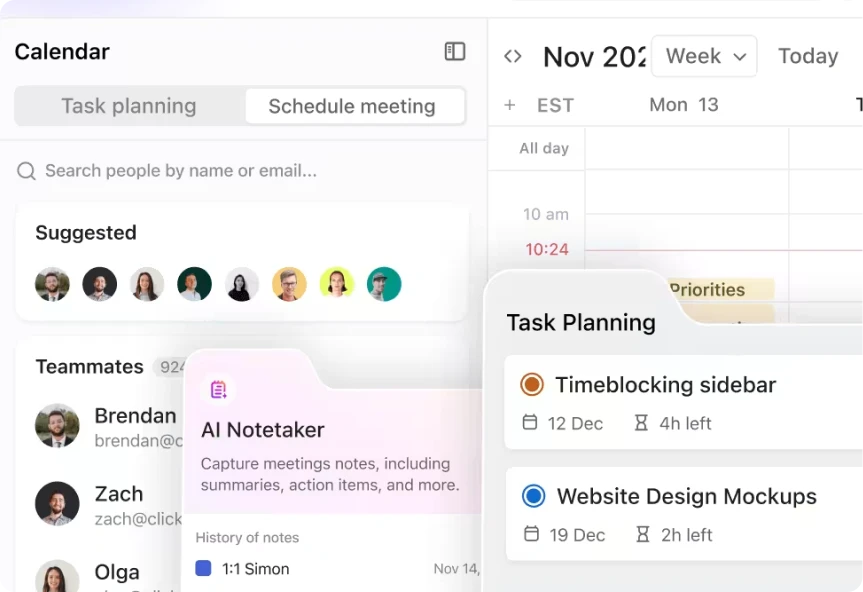The Agentic Orchestration Series, Part 4: How Autonomous Test Execution is the Muscle of the Operation
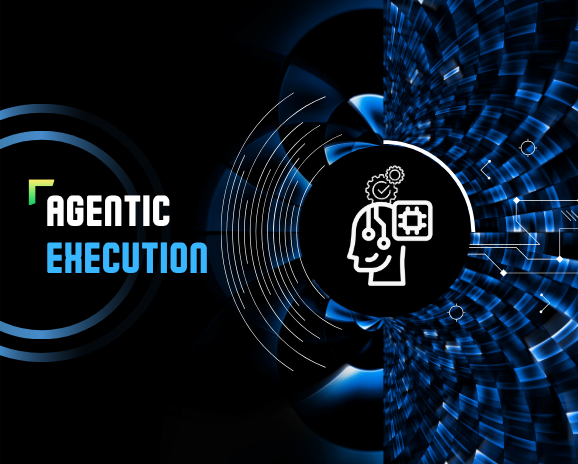
How the Qyrus SEER Framework Redefines Test Execution
In today’s hyper-productive environment, where AI assistants contribute to as much as 25% of new code , development teams operate at an unprecedented speed. Yet, QA often struggles to keep up, creating a “velocity gap” where traditional testing becomes the new bottleneck. It’s a critical business problem. To solve it, you need more than just automation; you need intelligent agentic orchestration.
This is where the SEER framework truly shines. It doesn’t just run a script. It conducts a sophisticated team of specialized Single Use Agents (SUAs), launching an intelligent and targeted attack on quality. This is the dawn of true autonomous test execution, an approach that transforms QA from a siloed cost center into a strategic business accelerator.
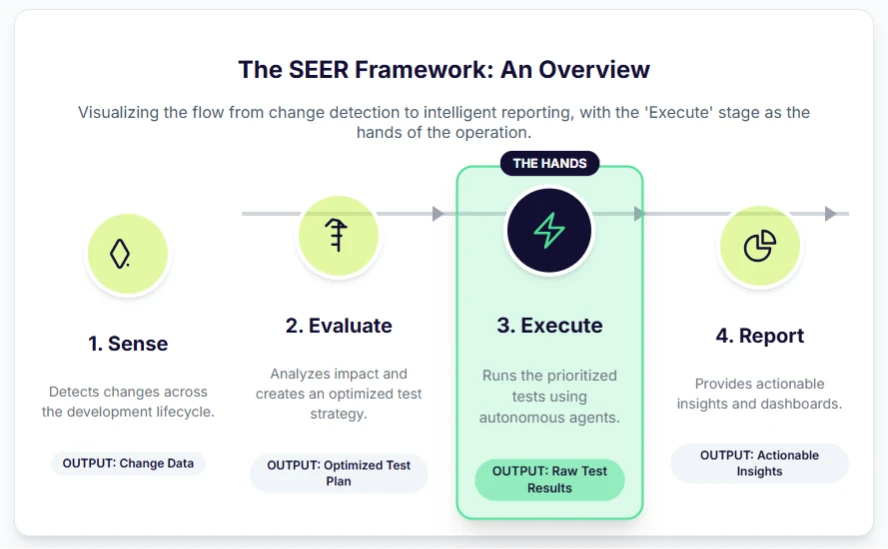
Unleashing the Test Agents: A Multi-Agent Attack on Quality
- The UI Specialist – TestPilot: When the user interface needs validation, SEER deploys TestPilot. This agent acts as your AI co-pilot, creating and executing functional tests across both web and mobile platforms. It simulates real user interactions with precision, ensuring your application’s UI testing is thorough and that the front-end experience is not just functional, but flawless.
- The Backend Enforcer – API Builder: For the core logic of your application, API Builder gets the call. This powerful agent executes deep-level API testing to validate your backend services, microservices, and complex integration points. It can even instantly virtualize APIs based on user requirements, allowing for robust and isolated testing that isn’t dependent on other systems being available.
- The Autonomous Explorer – Rover: What about the bugs you didn’t think to look for? SEER deploys Rover, an autonomous AI scout that explores your application to uncover hidden bugs and untested pathways that scripted tests would inevitably miss. Rover’s exploratory work is a crucial part of our AI test execution, ensuring comprehensive coverage and building a deep confidence in your release.
- The Maintenance Expert – Healer: Perhaps the most revolutionary agent in the squad is Healer. Traditional test automation’s greatest weakness is maintenance; scripts are brittle and break when an application’s UI changes. Healer solves this problem. When a test fails due to a legitimate application update, this agent automatically analyzes the change and updates the test script, delivering true self-healing tests. It single-handedly eliminates the endless cycle of fixing broken tests.
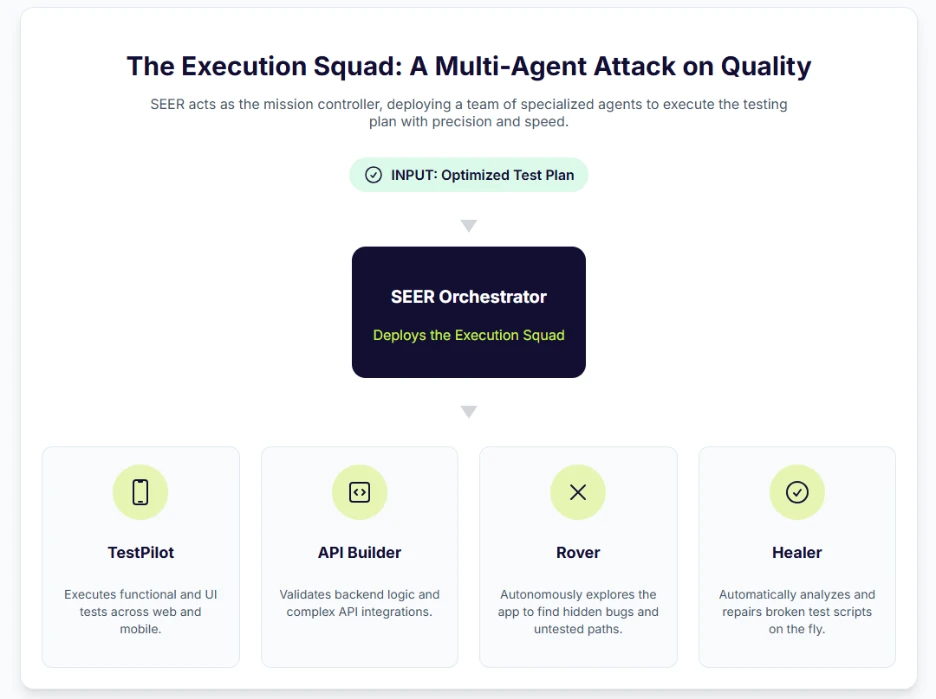
Behind the Curtain: The Technology Driving Autonomous Execution
First, Qyrus plugs directly into your existing workflow through flawless continuous integration. The moment a developer merges a pull request or a new build is ready, the entire execution process is triggered automatically within your CI/CD pipeline, whether it’s Jenkins, Azure DevOps, or another provider. This eliminates manual hand-offs and ensures that testing is no longer a separate phase, but an integrated part of development itself.
Next, Qyrus shatters the linear testing bottleneck with massive parallel testing. Instead of running tests one by one, our platform dynamically allocates resources, spinning up clean, temporary environments to run hundreds of tests simultaneously across a secure and scalable browser and device farm. It’s the difference between a single-lane road and a 100-lane superhighway. This is how we transform test runs that used to take hours into a process that delivers feedback in minutes.
The Bottom Line: Measuring the Massive ROI of Agentic Orchestration
- Slash Testing Time and Accelerate Delivery: By orchestrating parallel testing across a scalable cloud infrastructure, Qyrus shatters the testing bottleneck. This allows organizations to shorten release cycles and dramatically increase developer productivity. Teams that embrace this model see a staggering 50-70% reduction in overall testing time. What once took an entire night of regression testing now delivers feedback in minutes, giving your business a significant competitive advantage.
- Eliminate Maintenance Costs and Reallocate Talent: The Healer agent directly attacks the single largest hidden cost in most QA organizations: script maintenance. By automatically fixing broken tests, Healer allows organizations to reduce the time and effort spent on test script maintenance by an incredible 65-70%. This frees your most valuable engineers from low-value repair work, allowing you to reallocate their expertise toward innovation and complex quality challenges that truly move the needle.
- Enhance Quality and Deploy with Bulletproof Confidence: Speed is meaningless without quality. By intelligently deploying agents like Rover to explore untested paths, the Qyrus SEER framework dramatically improves the effectiveness of your testing. This smarter approach leads to a 25-30% improvement in defect detection rates, catching critical bugs long before they can impact your customers. This allows your teams to release with absolute confidence, knowing that quality and speed are finally working in perfect harmony.
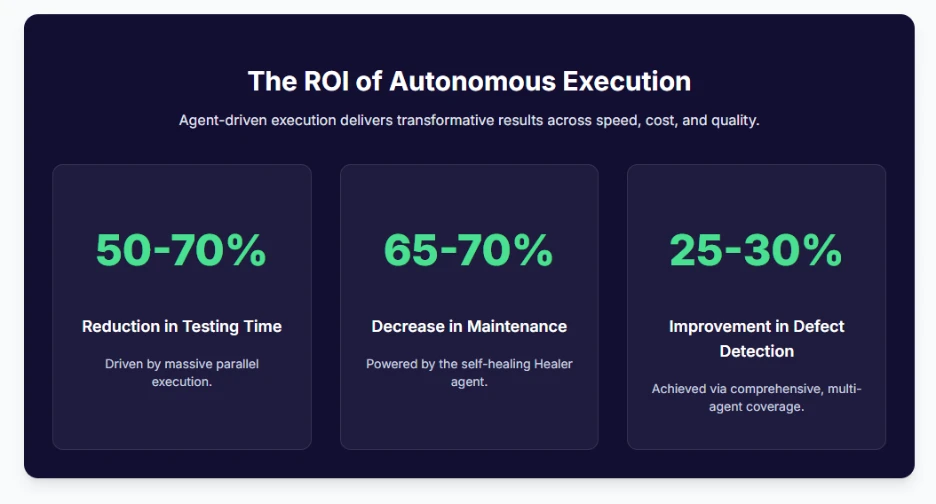
Conclusion: The Dawn of Autonomous, Self-Healing QA
The Qyrus ‘Execute’ stage fundamentally redefines what it means to run tests. It transforms the process from a slow, brittle, and high-maintenance chore into a dynamic, intelligent, and self-healing workflow. This is where the true power of agentic orchestration comes to life. No longer are you just running scripts; you are deploying a coordinated squad of autonomous agents that execute, explore, and even repair tests with a level of speed and efficiency that was previously unimaginable.
This is the engine of modern quality assurance—an engine that provides the instant, trustworthy feedback necessary to thrive in a high-velocity, CI/CD-driven world.
But the mission isn’t over yet. Our autonomous agents have completed their tasks and gathered a wealth of data. So, how do we translate those raw results into strategic business intelligence?
In the final part of our series, we will dive into the ‘Report’ stage. We’ll explore how the Qyrus SEER framework synthesizes the outcomes from its multi-agent attack into clear, actionable insights that empower developers, inform stakeholders, and complete the virtuous cycle of intelligent, autonomous testing.
Ready to Explore Qyrus’ Autonomous Test Execution? Contact us today!





